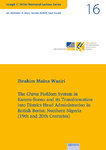Verlag für Wissenschaft und Praxis
- ISLAMWISSENSCHAFT
- ISLAMISCHE STUDIEN
- JOSEPH C. MILLER MEMORIAL LECTURES SERIES
- ASIENWISSENSCHAFT
- ARCHÄOLOGIE ALS KULTURWISSENSCHAFT
- RELIGIONSWISSENSCHAFT
- RELIGIONSPÄDAGOGIK
- GESELLSCHAFT UND KIRCHE
- KIRCHE UND GEMEINDE
- GESUNDHEIT UND KRANKHEIT
- KINDERGARTENPÄDAGOGIK
- OPEN ACCESS
- Neuerscheinungen
- In Vorbereitung
- News
- E-Books
- Einzelkataloge
Categories OPEN ACCESS Reihe: Joseph C. Miller Memorial Lecture Series Vol. 5: Clay embodiments:Materializing Asymmetrical Relations in Pre-Hispanic Figurines from Ecuador
Vol. 5: Clay embodiments:Materializing Asymmetrical Relations in Pre-Hispanic Figurines from Ecuador
Artikel-Nr.: ISBN 978-3-86893-398-745 pages, paperback,
14,8 x 21,0 cm, 2021
Hier können Sie die Publikation als
CC BY-NC-ND 4.0-Lizenz herunterladen:
DOI: https://doi.org/10.53179/9783868933987
The longest tradition of figurine production in the Americas is found on the Ecuadorian coast, beginning with the Valdivia culture around 3500 BC and ending with the arrival of Spanish conquistadors, or possibly even later. In this article, figurines from different cultures and time periods in this tradition are analyzed with an emphasis on body politics, presenting the author’s reflections about how these artifacts embody ancient relations between people, especially with regard to gender asymmetries. It also discusses at some length the question of how contemporary perspectives for analyzing ancient materials are often influenced by western, patriarchal, ideology-laden interpretations.
Although the corpus of figurines analyzed in this research is well known, prior to this study it has not been considered from the perspective of gender asymmetries, even though it is an excellent source of data for such analyses, especially in a diachronic perspective. The study argues that the figurine traditions of particular cultures implicitly emphasize some ideals, such as naturalizing the idea of females depending on males. The author argues that the frequent representations of female individuals associated with pregnancy and childcare can be seen as a political agenda designed to idealize the roles of mother and wife for women, and to limit the influence of female individuals in public activities connected to power and authority.
The Author
María Fernanda Ugalde (Pontificia Universidad Católica del Ecuador) is an Ecuadorian archaeologist. She holds an M.A. and a PhD from Freie Universität in Berlin, with a specialization on Ancient American Cultures. She has worked on many topics and time periods. In recent years her focus lay, amongst others, on gender archaeology, body politics, and iconographic studies. She is the (co-)author of four books, including her PhD dissertation which was published in Germany in the series Forschungen zur Archäologie Außereuropäischer Kulturen des Deutschen Archäologischen Instituts. Her papers have been published in several countries.






































